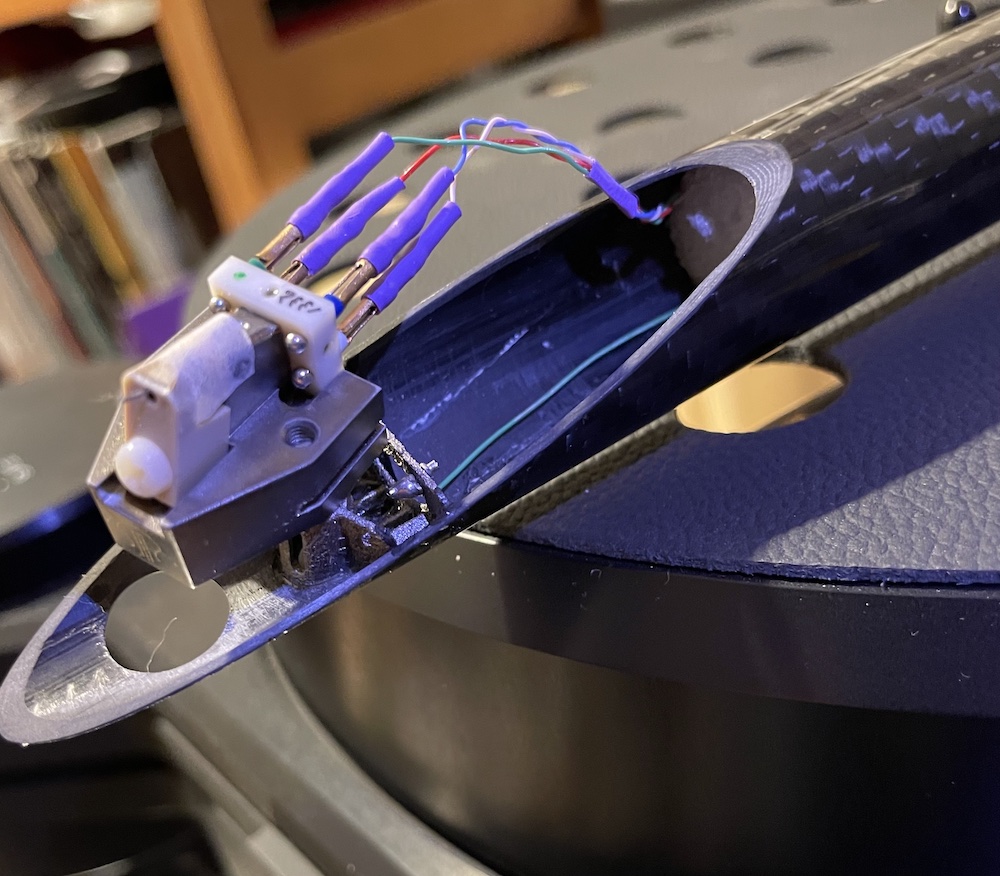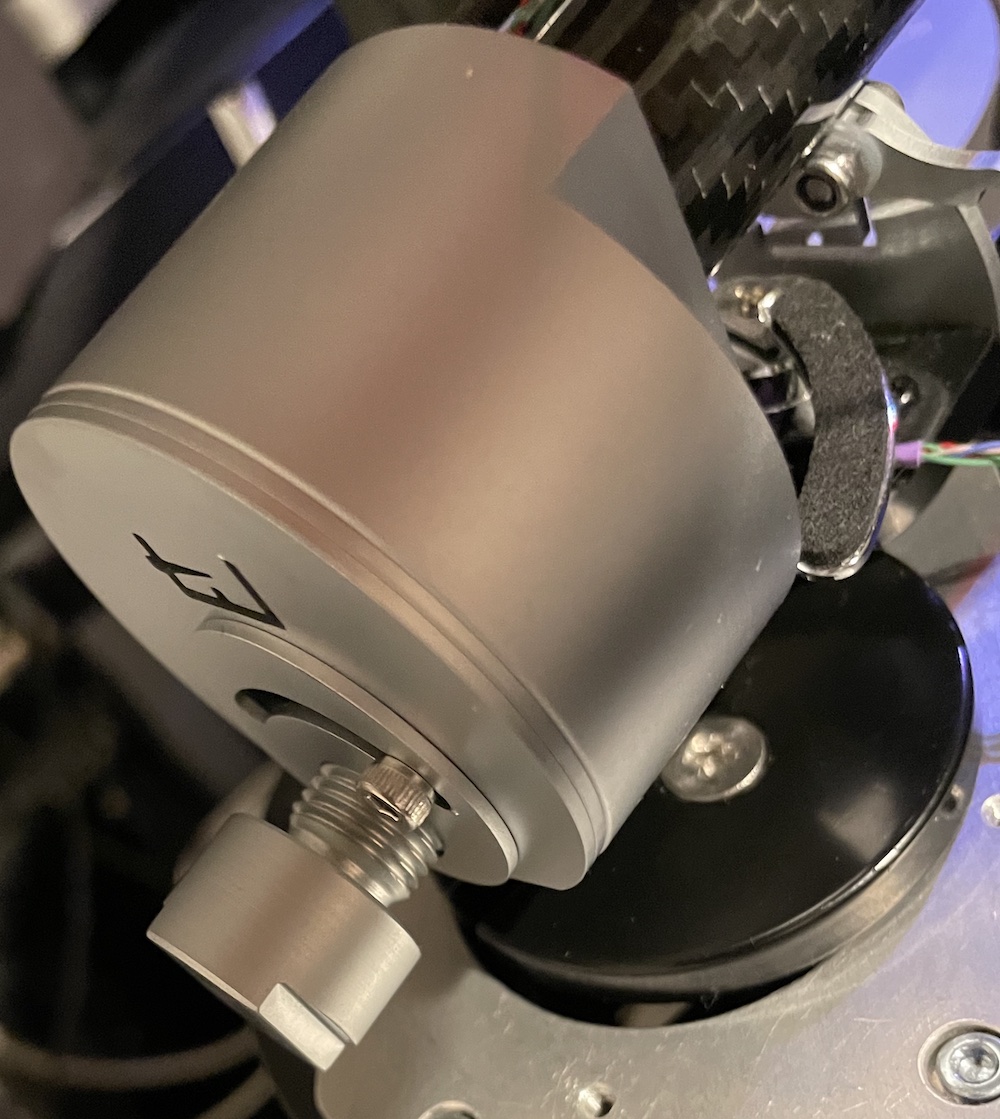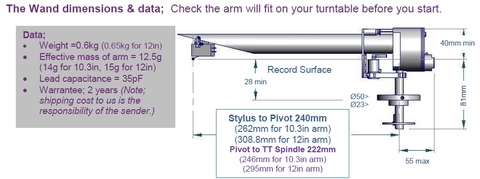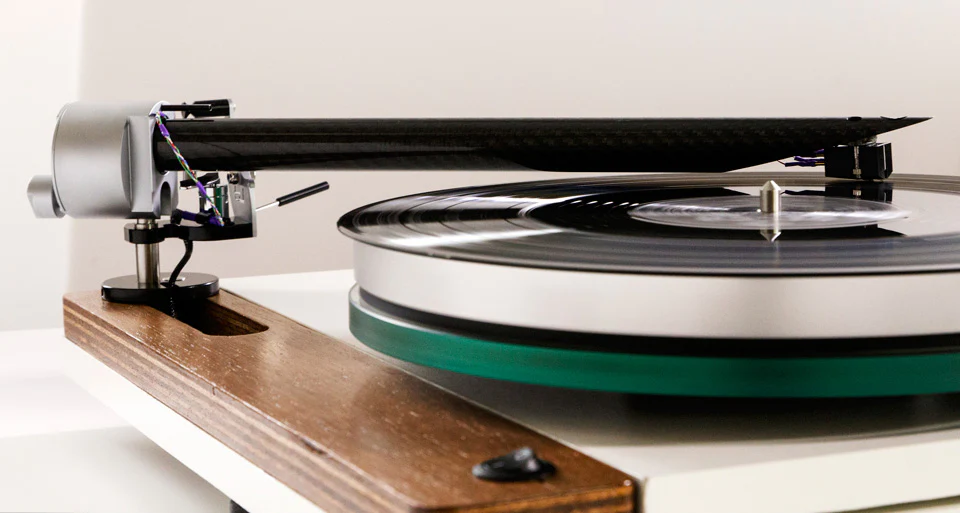What's the Magic in "The Wand"?
a high performance tonearm at a budget price
This is a years-in-the-making saga, but it’s not as long as Design Build Listen has been manufacturing The Wand tonearm. Inventor Simon Brown introduced it in 2011. A sample arrived here more than a few years ago and a review commenced, but shortly thereafter, the New Zealand built arm’s American distributor exited, orphaning the review.
Unbeknownst to me, a short time later a new distributor entered and delivered a The Wand arm to my dear, late friend Art Dudley, who reviewed it in the pages of my previous endeavor. Now, with my nascent review no longer redundant, and a newer distributor in place—Profundo Audio (once distributor of Immutable Music’s no longer manufactured Transfiguration cartridges)— it is time to resurrect The Wand tonearm review.
The Wand Plus I was sent is still in production, with perhaps the usual minor revisions that occur time to time with most long-lived products, so the importer felt comfortable with me reviewing what I had, though he did say the instructions have been upgraded, which is a good thing because the ones I got were of the “clearly written by the designer/manufacturer” kind. Designers should never write their own instruction manuals. They go into it knowing too much so they inevitably make unwarranted assumptions and omit “obvious” details or steps.
It's too easy and too much fun to make fun of ambiguous instructions but since the importer says they’ve been made better and easier to follow I won’t carp about them. Plus, now there are very useful videos and a plethora of set up guidance on the Design Build Listen website. This is a “do it yourself” product that you actually can do yourself.
The unipivot The Wand is available in three lengths (9.5”, 10.3” and 12”) and in three spec levels, the Plus being the basic model and the one I was sent in the 9.5” length. At the time I received it, there was one model below it that’s since been discontinued. The 9.5” model reviewed here costs $1950.
The “wand” itself is an almost inch in diameter carbon fiber tube sliced at the underside end at a severe angle to produce what you see in this photo—an elliptical opening into which is cemented at the geometrically correct offset angle a metal cartridge mounting platform tapped and threaded to accept the screws. So there’s no “head shell” per se, which only increases the rigidity of an already rigid pipe. One mounting hole is adjacent to the tube and the other is accessed via a hole drilled into the center of the tube.



The rear of the arm terminates in a high mass bearing block/counterweight in the center of which is an opening containing a brass insert into which fits the tall, topped with a jeweled cup, bearing post.
 two large washer/shims plus one small one attached to rear of the block plus fine VTF adjustment bolt.
two large washer/shims plus one small one attached to rear of the block plus fine VTF adjustment bolt.
The design has the advantage of putting the large block/counterweight’s mass directly above the bearing interface, which increases stability while eliminating “bearing chatter”. Tracking force is adjusted by adding supplied washer/shims to the back of the block and then “fine tuning” VTF via a large, threaded bolt. The washer/shims attach asymmetrically to the block’s allowing the weight to be laterally redistributed to set azimuth. Anti-skating is adjusted with a thread and weight system.
The Set Up
If you’ve thought this through while reading the above description you’ve realized that neither zenith angle nor “overhang” can be adjusted on the “wand” itself. In that design aspect, “The Wand”’s “overhang” set-up is conceptually identical to SME’s: with the cartridge fixed in a slotless space, “overhang” can only be adjusted by changing the pivot to spindle distance.
Most of SME’s arms adjust pivot to spindle distance using a smooth sliding, but costly to manufacture “sled”. “The Wand” asymmetrically mounts the bearing post on a plastic housing that locks onto your armboard using a single threaded bolt. Rotating the housing changes the pivot to spindle distance. Effective and far less costly. “The Wand” comes with a substantial metal protractor that precisely sets the drill point as well as set “overhang” to “Baerwald” geometry though using it for that made me uncomfortable because of the sharp metal edge that you’re forewarned to not let the stylus touch. I’d get an external overhang gauge. I used the WallyTractor. The arm's 9.5" arm geometry mirrors Rega's: P2S (pivot to spindle) distance is 222mm, pivot to stylus tip (overhang) is 240mm.

A nice advantage of this methodology is that tracking force, once adjusted, doesn’t change with overhang since the distance between the cartridge and counterweight doesn’t shift. And it has one disadvantage shared with SME’s slotless headshell: there’s no way to adjust zenith angle. Hopefully, at the very least, your cartridge’s cantilever isn’t “skewed”, though as we’ve come to find, that’s no guarantee that the stylus’s has been inserted perpendicular into the cantilever! Not a problem, of course, if you’re using a spherical stylus (not recommended by me).
The single drilled hole mount makes this fairly easy and there are other mount options you can find on the Design, Build, Listen website, including specific mounting instructions for Rega, Linn, Michell, Lenco, Technics and other arms. I mounted the arm onto an Acoustic Signature Montana NEO turntable pre-fitted with an SME type mount armboard, but I removed that for logistical reasons and used a Graham Engineering SME type mounting plate I had around here for decades, bolting it to the pre-drilled holes in the armboard. “The Wand”’s design makes its mount “improv friendly”.

That said, because of the somewhat unusual design, it’s not a bad idea to first “practice” using an inexpensive cartridge, or one in which you can remove the stylus. On the subject of appropriate cartridges you can use everything from a low compliance MC to a Shure V15 VxMR and get an acceptable arm/cart resonant frequency. “The Wand” is a cartridge friendly arm!
I installed a Lyra KLEOS on the arm, set tracking force to 1.72, which was relatively easy to do using the recommended number of washers as a starting point and then using the large adjustment bolt. One big caution: because the arm’s center of gravity lies well below the pivot point, you must measure tracking force at or very close to the record surface, or you will be tracking far lighter than you think or want.
An arm with a center of gravity well below the pivot “wants” to go down. Measuring well above record height will give you a false high tracking force that will be much lower at the record surface. Measuring well above the record surface (higher than any gauge I know of) produced close to a 3 gram reading, while a gauge capable of measuring at the record surface produced 1.72. If your gauge’s measuring platform is 1/4” or more above the record surface, add at least .1 gram above what your gauge reads (if you desire 1.72, set it to 1.82 or possibly even a bit higher).
Setting “overhang” was also relatively easy, though it requires removing the arm each time you make a “fore/aft” adjustment.
To set VTA/SRA, with the arm removed, you loosen an Allen bolt and adjust the height of the bearing post. The supplied P2S/overhang jig includes a basic arm height guide that will get it close to parallel with the record surface as a starting point.
In other words, you’re not adjusting this parameter once the arm is finally set up, or at least you’re adjusting it and once satisfied with the sound, you’re leaving it alone! This is not an arm for “VTA/SRA on the fly” enthusiasts, of which I am not one. I set for 92-93 degrees and leave it!
Only at this point do you add the platform that is an armrest/lock, and a support for both the cueing and anti-skating mechanisms, both of which will require considerable “fiddling” until you get them properly height adjusted.
Setting anti-skating is easy and basic but you must carefully adjust the tonearm wire loop and its angle relative to the arm because it can otherwise exert a substantial anti-skating force. If you haven’t a way to accurately measure this using a WallySkater or however you do it, “less is more” here. Speaking of tonearm wire, my sample came with a three foot + long straight run from gold plated cartridge clips to low mass Eichmann RCA plugs of Cardas cable.
I set azimuth using the Fozgometer V2 rather than the digital oscilloscope method because the Foz 2 is more likely to be uses by the average “The Wand” buyer and the results comport well with oscilloscope follow up checks.
Use and Listening
You’ll note there’s no finger lift so either use the cueing mechanism or if you want to do it manually, press your thumb against the arm’s front curved edge and carefully lower before withdrawing it. I found that worked well. Otherwise, this somewhat unconventional, ingeniously designed arm’s behavior was 100% normal.
The first record I played was one I know really well: The Weavers at Carnegie Hall-1963 recorded May 2nd and 3rd or 60 years to the days I finalized this review. You’re not likely to hear a better recorded live concert. I played the Analogue Productions 33 1/3 reissue rather than Classic’s 45rpm single sided box set.
The playback delivered everything I’d hoped to hear that this record can produce, but of course couldn’t be sure it would: rock solid image stability and accurate three-dimensional, airy soundstaging, the eerily natural, artifact-free vocals and stringed instrument transient precision. I also clearly heard all of the Kleos’s most attractive “gossamer-like” midband qualities. And, when the musicians tapped their feet on the stage, something the microphones picked up with amazing clarity, “The Wand” delivered all of the low frequency energy with full extension, transient precision and deft decay. Backgrounds were notably quiet.
I could have stopped there because I was pretty sure of what every other familiar record would sound like and all did. My friend Brian Speiser recently produced for Amy Ray (Indigo Girls) If It All Goes South (Daemon Records DAM 19064-1) a mostly AAA record (a few tracks were recorded 96/24 and then transferred to tape so the final master could be cut from tape by Kevin Gray at Cohearent) I’ll get around to writing a full review of as soon as possible, that I’ve been playing incessantly both for its warm, inviting sound and for its honest musical pleasures.
The album’s mix of acoustic and electric instruments honestly recorded produces generous sonic pleasures on a mostly joyful album of songs about Ray’s love/hate relationship with broken rural America or as she sings on “They Won’t Have Me”, “They won’t have me, but I love this place.”
There’s authoritative bottom end mixed with banjos, mandolins, dobro, fiddles and the like behind Ray’s powerful vocals and “The Wand” delivered it with more of the weight, clarity and transient precision on some of the busier tracks like The Band-like “Cowboys and Pirates” that features brass, pedal steel, piano, dobro, fiddle and more than I could possibly expect from a $1950 arm or for that matter, from a $3000 one. Was the $1950 arm's performance remotely equal to the $50,000 SAT with the Audio-Technica MC2022 installed? No. But was the improvement worth the 10X+ cost? The law of diminishing returns sets in there, but if you had the money and the will, you'd opt for the costly combo. Nonetheless, The Wand at $1950 with the Kleos was a formidable and affordable combo. The Wand can be made to fit so many existing 'tables, even those with integral arms, it's a serious upgrade contender across a universe of platforms.
Conclusion
Don’t let the “fiddly” nature of “The Wand”’s set-up deter you from considering it as an arm of choice for your next new turntable or as a “drop in” replacement for your round holed older Rega arm, or other turntable you wish to upgrade with a new arm. I auditioned it on a $33,995 Acoustic Signature Montana NEO and its performance amazed and actually baffled me. How can something this inexpensive perform so well in every possible sonic and mechanical parameter—but especially in the bottom octaves? I don’t need an answer. It just does.
Once it was set up, “The Wand” behaved as do more conventional arms and it also “held” its settings as well. You could splurge on a costly ‘table and add a “The Wand” now to stay within your budget and upgrade later though you might just end up sufficiently satisfied to stop there. Or, pop one of these on an older Rega or Michell and you might be good to go for another decade. Well, depending upon your age, at least your turntable is certain to be!
Finally, I need to thank both Acoustic Signature and importer Rutherford Audio for letting me hold on to the Montana NEO for a very long time so I could write reviews of the Kuzma Safir 9" and The Wand 9.5" because neither were useable on my reference OMA K3 that requires 12" arms.










































.png)








